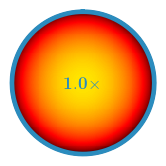Data Guide | Mini-Millennium
This simulation is good for ...
- Modelling galaxies with stellar mass above ~10^8.5 Msun to the knee of the mass function
- Running tests for box-type data products
Overview
This simulation carries the same cosmology and resolution as the full Millennium simulation, but is simply a smaller periodic box. Semi-analytic models are typically calibrated on smaller versions of simulations, like Mini-Millennium, before the full simulation catalogues are produced. Mini-Millennium is recommended for those who want to quickly sample data products from TAO. The smaller data volume is much easier to handle for testing pipelines, and results concerning galaxies (with the exception of those in massive clusters) should be representative of the larger simulation.
Relative size
- Box length: 62.5 h^-1 Mpc
The volume relative to Millennium and an all-sky survey out to z=0.05:

Mass resolution
- Particle mass: 8.6 × 10^8 h^-1 Msun
- Gravitational softening: 5 h^-1 kpc
- Number of particles: 270^3
- Number of snapshots to z=0: 64
The particle size compared to Millennium:

The mass resolution of Millennium and Mini-Millennium are identical.
Cosmology
The cosmological parameters of the Millennium simulation are based on WMAP-1 data (Spergel et al. 2003) and the 2dF Galaxy Redshift Survey (Colless et al. 2001).
- Ω_M = 0.25
- Ω_Λ = 0.75
- Ω_b = 0.045
- σ_8 = 0.9
- n = 1
- h = 0.73
Haloes
Haloes and subhaloes were identified using the popular SUBFIND code. The merger trees of these haloes were built using LHALOTREE, which is described in the Supplementary Information of the Millennium paper. A minimum of 20 particles was required for a (sub)halo to be included in the trees.